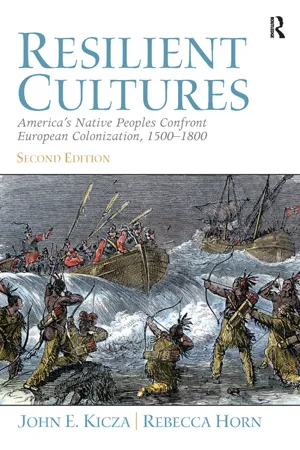History
Conquistadors
Conquistadors were Spanish soldiers, explorers, and adventurers who sought to conquer and colonize the Americas during the Age of Discovery in the 15th and 16th centuries. Led by figures such as Hernán Cortés and Francisco Pizarro, they played a significant role in the Spanish colonization of the Americas, often using military force to subjugate indigenous peoples and establish Spanish control over vast territories.
Written by Perlego with AI-assistance
Related key terms
3 Key excerpts on "Conquistadors"
- eBook - ePub
Latin American History Goes to the Movies
Understanding Latin America's Past through Film
- Stewart Brewer(Author)
- 2015(Publication Date)
- Routledge(Publisher)
Wealthy and not-so-wealthy noblemen sought their fortune in the New World. Second sons who did not stand to inherit looked to the New World as a place of new beginnings and limited social hindrances. Clergymen saw the New World as a land ripe for proselytizing, a continent filled with vast groups of people in need of the gospel of Jesus Christ. But whatever their reasons, Spaniards, Portuguese, and other Europeans flocked to the Americas in ever-increasing numbers, searching for a new life in the New World. Of course, when the peoples and cultures of the Old World encountered and interacted with those of the New World, conflict was a frequent outcome. And, because of certain advantages discussed below, the European explorers and conquistadores managed to subdue countless numbers of Amerindians, while untold hundreds of thousands died from disease, warfare, and poverty. The Conquest of Latin America The conquest of Latin America took place throughout the sixteenth century and even into the seventeenth century in some locations such as the Maya highlands. The term “conquest” is habitually problematic because the overthrow of Latin America involved much more than just the military subjugation of the various Indian populations in the Americas. In addition to military strength, the conquest also involved an ecclesiastical transformation, as Indian religions were supplanted by Roman Catholicism; Indian social networks were disrupted by the Spanish Caste System; and Indian economic and agricultural practices were transformed by Spain’s desires for silver and gold that they brought with them across the Atlantic Ocean. Nevertheless, all of these aspects of subjugation began in a few specific locations. The Spanish conquest of two major Amerindian civilizations of Latin America, the Aztecs of central Mexico, and the Inca of the Andes, set in motion Spain’s eventual hegemony over most of the Western Hemisphere - eBook - ePub
Resilient Cultures
America's Native Peoples Confront European Colonialization 1500-1800
- John E Kicza, Rebecca Horn(Authors)
- 2016(Publication Date)
- Routledge(Publisher)
Spaniards also encountered hunters and gatherers who lived in the deserts, plains, and jungles of the Americas. In general, Spaniards quickly withdrew from these areas once they ascertained the lack of exploitable resources and the character of the inhabitants. Hence, they did not become significant zones of colonization until centuries later. These regions were not conducive to agriculture, and the indigenous population was small in number, resilient in warfare, and resistant to forced labor service. Sixteenth-century Spanish expeditions journeyed across the North American plains, the Amazon drainage basin, and the South American pampas, but withdrew because of their lack of appeal. Only the lure of silver mines might attract Spaniards to such regions, as in the Mexican north. Spanish colonists congregated in Mesoamerica and the Andean region for their exploitable resources and numerous laborers.ConclusionThe conquistadores who defeated the great empires of the Aztecs and Incas should not be distinguished from the other early colonists in Spanish America. They had the same backgrounds, abilities, motives, and assets. The “conquerors” just found themselves in situations where extended combat (or combat readiness) was required. Once they had prevailed, they became in most respects indistinguishable from the other settlers who arrived early on but had avoided combat.Although the expeditions against the Aztecs and Incas captured the emperor and ruled through him for some time, in both cases the Spaniards, with the aid of their indigenous allies, ultimately had to defeat the imperial center led by members of the ruling family in grueling combat. Only when thoroughly defeated in warfare did the imperial dynasties acknowledge the permanent subordination of themselves and their peoples.The native societies invariably viewed the Europeans through their traditional cultural lenses. They did not consider them as gods, or even as particularly alien beings who could not be understood and should be held in awe. Instead, they commonly understood them to be quite similar to themselves in their goals, expectations, and values. Indigenous rulers were quick to negotiate with the strangers and to seek to make use of them for their own ends. Overall, the Indians did not regard the Europeans as especially “other,” nor did they become passive and slow to respond to the new, unexpected situation. Native leaders commonly proposed alliances and strategies with Spanish expeditions, contributing in this way to the collapse of indigenous empires. At times, they clearly manipulated the intruders for their own ends without the Spanish commanders understanding how they were being used. - Lawrence A. Clayton(Author)
- 2010(Publication Date)
- Wiley-Blackwell(Publisher)
The news was good then also. Indians in rebellion! This meant that one could make war on them legally to restore them to Spanish authority, and to enslave them legally.The old nightmare crossed Las Casas’s horizon as he disembarked and hurried to see Antonio de la Gama, the Chief Justice of Puerto Rico who had just completed a special investigation for the Crown on the island. In the meantime, while Las Casas launched his second great experiment in settling the Indies and social planning, Cortés was waging a hotly contested war against the Aztecs of Mexico.The conquest of MexicoThe conquest of Mexico is the focal point of the Spanish invasion of the New World. It set the mark for the Spaniards.2 It has long been seen as testimony to the magnificent feats of arms by a handful of Spanish warriors in the midst of an Amerindian empire of millions in the heart of Mexico. Cortés led an expedition of about 550 men to the coast of Mexico in 1519 and in the space of two years he conquered tens of thousands of warriors in the combined armies of the Aztecs and their allies.Modern research has altered this view somewhat.3 It turns out that “General Smallpox,” or the role of diseases in undermining both the will and the substance of the Aztec resistance to the invasion, especially of the Aztec capital of Tenochtitlán which the Spanish first entered on November 8, 1519, played at least an equal role in determining the winners and losers in this titanic struggle for triumph or survival (depending on your point of view) in the central valley of Mexico.Second, the role of the Aztec tributary peoples—those conquered by the Aztecs—played an immense role in the defeat of the Aztecs. Once defeated by Cortés, they turned into very willing allies, using the Spanish to make war on their old enemies and conquerors, the Aztecs themselves. “The conquest,” wrote one historian, “was more like an internal revolution against Aztec rule than a European invasion of an Amerindian state.”4
Learn about this page
Index pages curate the most relevant extracts from our library of academic textbooks. They’ve been created using an in-house natural language model (NLM), each adding context and meaning to key research topics.


